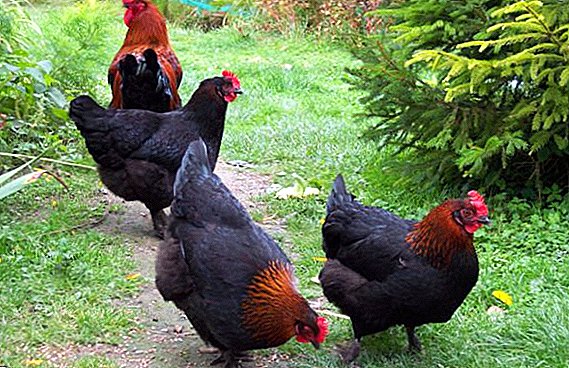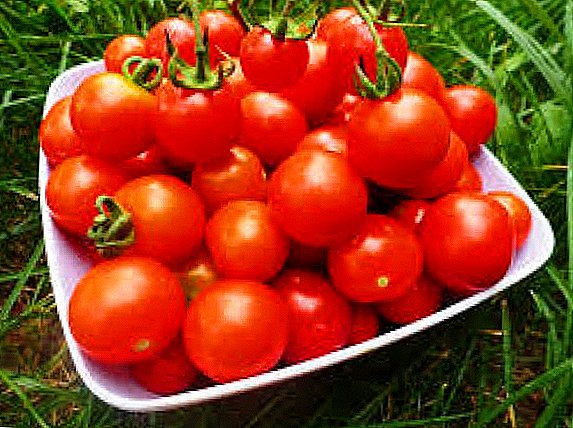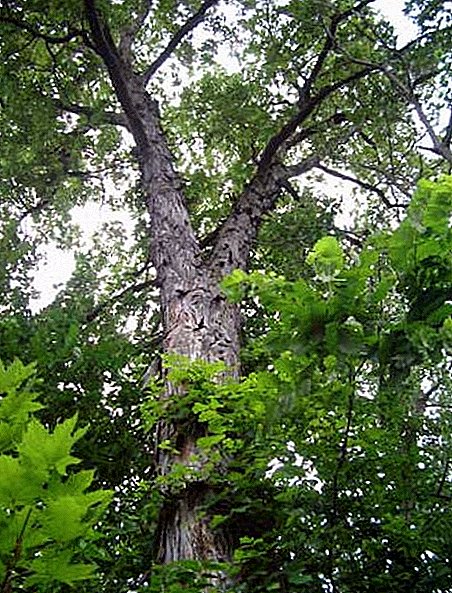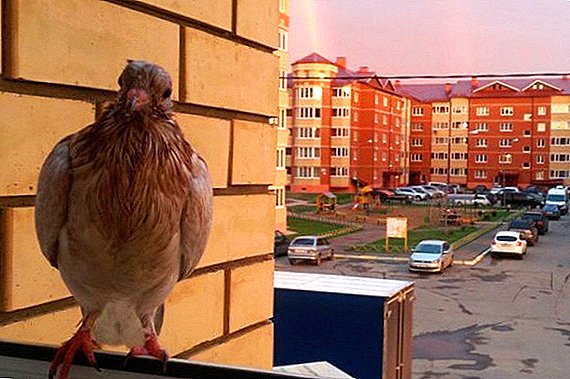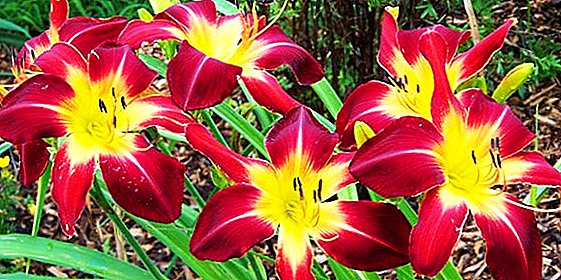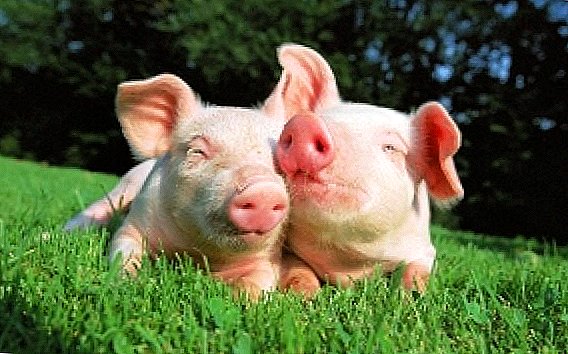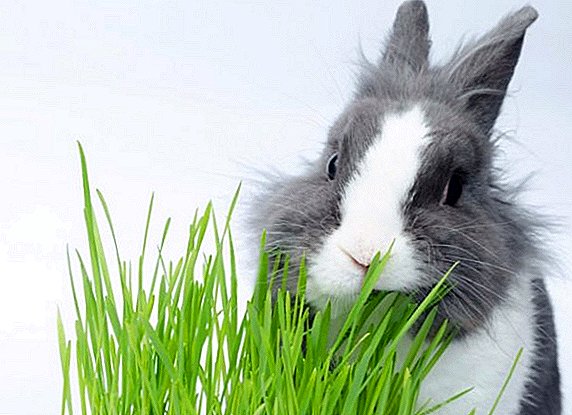 Whatever vegetation you offer eared, they will gladly eat it. But not all stems will benefit them.
Whatever vegetation you offer eared, they will gladly eat it. But not all stems will benefit them.
Proceeding from the fact that the green mass all year round is an important component of the daily diet of these cute animals, and their digestive system is very sensitive to the chemical components of food, we’ll try to figure out what grass rabbits can eat and what they don’t.
Meadow
Herbs gathered in the meadows, fields and forests are also valued for their ecological clean. Experts advise to harvest raw materials in the outback of nature, away from dusty and polluted roads, industrial enterprises. Such stalks will not only bring feelings of satiety, but also enrich animal organisms with vitamins and microelements. In addition, most meadow herbs have an anti-inflammatory milky effect.
Important! In the spring-summer season, when raznotravya rampant, green mass in the diet of rabbits half replaces the feed and cereals.
Veterinarians believe that more benefits from young plants, as in their composition proteins prevail and fiber is practically absent. Therefore, it is advised to harvest grass for hay before the appearance of buds, when the stems are still soft. In addition, it is not recommended to overexpose raw materials in the sun. The workpiece should keep the green saturated color and fresh flavor.  If this recommendation is ignored, then with a later mowing you will get emasculated hay, which is low in nutrients and high in fiber. Such food is very difficult to digest and does not bring any benefit. Moreover, grass for rabbits needs to be alternated, since the same type of food ceases to arouse interest even in the most useful feeds.
If this recommendation is ignored, then with a later mowing you will get emasculated hay, which is low in nutrients and high in fiber. Such food is very difficult to digest and does not bring any benefit. Moreover, grass for rabbits needs to be alternated, since the same type of food ceases to arouse interest even in the most useful feeds.
Experts advise not to feed the eared one with only biomass. For good digestibility and maximum return, it should be mixed with other root crops, dry ingredients and compound feeds. Otherwise, animals may develop flatulence and indigestion.
Did you know? In Australia, wild rabbits are considered the worst enemies of the local population and agricultural enterprises. In the country at the state level, a ban has been imposed on the breeding of these seemingly cute animals. Each violator is threatened with a fine in the amount of 30 thousand US dollars. As it turned out, the mammals angered the aborigines with their vigorous life activity, the annual losses from which are estimated at around 600 million US dollars.
Let's talk about what meadow grasses are eaten by rabbits. The most nutritious of them are the following:
- sylphs (can be used for harvesting hay and silage, for the season it is possible to make 2 mowing);
- red clover (characterized by an increased amount of protein, allowed in small portions);
- fodder lupine (the plant must be mixed with other fodder, otherwise a legume will provoke an eating disorder);
- oats (over the summer period, the plant is sown twice and mowed in June and September);
- alfalfa (contains a lot of protein and amino acids, is useful for young, sucker lactating individuals);
- vetch (often mixed with green oat stalks and cereals);
- young corn (its biomass is well combined with leguminous plants, while it should not exceed 70 percent of the total feed);
- Sida (recommended in small portions in the dried form);
- rye (winter varieties mow when the stems begin to fall into the tube).









Did you know? If people did not interfere in the reproductive processes of rabbits and allowed them to freely reproduce, then in 90 years the number of these animals would be equal to the number of square meters on the globe.
From the garden
In order to feed a household, a rabbit breeder does not have to go in search of feed somewhere in the forest or on the meadow. Nutritional ingredients for the daily eared ration can also be found in the backyard. In addition, in this way from the usual care of the garden and the garden you can get double benefit.
We advise you to read about how to make a feeder (in particular, bunker) and a drinker for rabbits.
Experienced owners know what kind of grass can be fed to rabbits, and during weeding the beds they set aside remote weeds, as well as thinned vegetables, remnants of cut branches of fruit trees.
Rodents consider this a delicacy:
- celery;
- beet tops;
- root vegetables and carrot stalks;
- rhubarb leaves;
- parsley;
- young peas (pods and lash);
- pepper;
- grape leaves and young vine;
- foliage fruit crops (elderberry, plum, apricot, bird cherry);
- wild clover;
- chaff;
- shepherd's bag;
- colza;
- chandra (dead nettle);
- quinoa















Important! Feed the rabbits only with weeds and the remnants of fruit and vegetable crops are strictly not allowed. Such a diet is detrimental to the health of animals. Try to keep the branches of fruit trees and bushes into the feeder no more than 1-2 times a week, and vegetable and weed plants make up no more than 30-40 percent of the total amount of feed.
Medicinal
This type of grass is not subject to the restriction on the procurement of raw materials only at the beginning of the growing season. On the contrary, young stalks and inflorescences are equally important to rabbits. the main thing - before feeding a little set up a potion.
Experts emphasize that even a small amount of medicinal herbs helps to improve the quality of meat products and rabbit hair. But in all the measure is important.
We recommend reading about the features of feeding decorative breeds of rabbits.
Medicinal plants should be given to animals in small quantities, mixed with common food. Otherwise, malfunctions in the digestion and even stunting are possible. Therefore, in the total amount of daily feed of these ingredients should be no more than 35 percent.
Rabbits love to feast on:
- wormwood (stimulates appetite and warns intestinal disorders, in case of overdose provokes nervous irritability);
- mint;
- melissa;
- dandelions (contain many proteins, cause appetite, with an overdose, they stop the growth of eared ones);
- stinging nettle (very nutritious and enriched with vitamins, it has a hemostatic and antibacterial effect, leaves collected at the end of June that need to be scalded with boiling water before feeding) are especially appreciated;
- cumin;
- coltsfoot (helps to improve digestion, collection begins in the second decade of May);
- plantain (promotes wound healing, enriched with proteins, minerals and amino acids);
- wheatgrass (gives a diuretic effect; only rhizomes are suitable for food);
- sage










Important! Never give rabbits wet grass. If it rains or dew, lay out the mowing to dry out and dry up a bit.
Poisonous
The threat to eared rodents are rotted, ripened and moldy sprouts. But even in a fresh arm there can be a poisonous culture. We will understand in more detail what grass should not be given to rabbits.
Veterinarians believe that even the most poisonous specimens in the dried-up form partially lose their toxic qualities. Therefore, when developing new unfamiliar areas, it is recommended to feed only dry vegetation to animals. This does not mean that by eating hay, rabbits will always be healthy.
It is important to ensure that the feed never gets:
- marsh calla (poisoning manifested by abdominal distention, increased salivation and anxiety);
- common dope (provokes paralysis and dysfunction of the cardiovascular system);
- hemlock (causes convulsions, paralysis of the hind limbs and contributes to loss of strength);
- Euphorbia (fraught with diarrhea, vomiting and cramps);
- poisonous milestone (paralyzes the respiratory organs, eating this herb in most cases is fatal);
- hellebore (in case of poisoning, trembling, vomiting, diarrhea, copious salivation, convulsions and breathing are observed);
- cornflower (provokes convulsions and paralysis);
- sleep-grass (helps reduce palpitations, causes intestinal disorders and shortness of breath);
- cockle (when ingested, causes paralysis, provokes dysfunction of the kidneys and heart, poisoning is expressed by weakness, diarrhea, vomiting and severe drooling);
- buttercups (grass causes acute pain in the abdomen, provokes flatulence, vomiting and diarrhea);
- autumn crocus (when eaten causes stomach upset, vomiting, drooling and bloating);
- wrestlers (help lower blood pressure, decrease heart rate and pulse);
- Avran officinalis (irritates the mucous membranes of the stomach);
- digitalis (provokes arrhythmia, convulsions, quickens pulse);
- celandine (except for indigestion causes seizures and general weakness of the body);
- marsh marsh marsh (the main symptoms of poisoning are frequent urination, diarrhea, bloating and colic).
















Did you know? In rabbits and hares, the eyes are arranged in such a way that they can simultaneously observe what is happening in front and behind.Often poisonous herbs are found on damp shady lawns.
Grass for rabbits
Knowing that you can not give the rabbits, it is important to ensure that poor-quality and toxic feed does not get into the trough. Let us analyze in what form the grass is best fed to animals, and how to properly harvest it for the winter.
Find out whether it is possible to give mugs to rabbits.
What can
For the eared to be healthy, to eat well and to grow quickly, it is not enough to know the names of the nutritional herbs. In addition, it is important to properly collect, store and prepare it.
Veterinarians advise only dry and slightly dried young plants. Fresh and old stems cause bloating and diarrhea. Therefore, prepare the feed ingredients always in advance. Do not be lazy for a few hours spread out the grass in the sun. 
What can not
The most important rule of rabbit breeders is to ban a wet potion. It can provoke intestinal disorders and destroy the animal. Some owners pre-rinse the grass with running water. After this procedure, the stems are subject to mandatory drying. At the same time, it is important to turn hay in time so that it does not moldy and does not pereprelo.
Important! In no case, rabbits should not be given decorative poppies, jasmine and other flowering plants. Eating them always ends with the death of the animals.
Experts are convinced that when the stalks come in contact with the metal of the scythe, the sap of the plants is oxidized, which does not have a very positive effect on the eared ones. In order not to risk, grass harvesting is advised to be carried out manually. It is also important to protect rabbits from musty, spoiled and dirty feed.
Now you know all about the nuances of the selection of vegetation for domestic eared. We hope our recommendations will help you in successful rabbit breeding.



